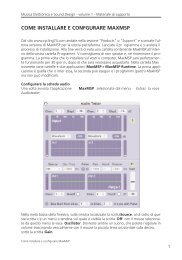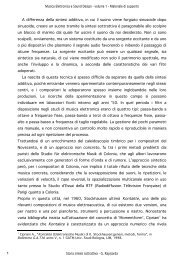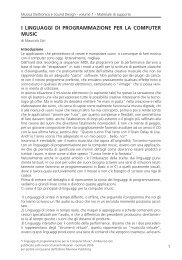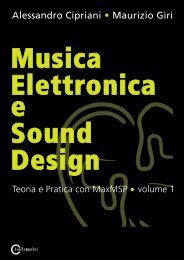programming with max/msp - Virtual Sound
programming with max/msp - Virtual Sound
programming with max/msp - Virtual Sound
Create successful ePaper yourself
Turn your PDF publications into a flip-book with our unique Google optimized e-Paper software.
Chapter 2P - Additive and vector synthesis 2P<br />
When it begins to drop from 0.5 towards 0, the oscillators are no longer in antiphase,<br />
and you hear a sound growing progressively in amplitude until the two<br />
oscillators are completely in phase and their summed amplitude ranges between<br />
-2 and 2. 4 Try using phase values larger than 1, and note that whenever the<br />
phase is equal to an integer, the sound reaches its <strong>max</strong>imum amplitude, and<br />
whenever the phase is exactly halfway between two integer values (such as 1.5,<br />
2.5, 3.5, etc.), the sound is cancelled out. Phase values larger than 1 (larger than<br />
360 degrees) cause the cycle to wrap around, beginning anew, as we explained<br />
in the box dedicated to phase in Section 2.1T. Of course, all of these observations<br />
hold true only if the two generators share exactly the same frequency.<br />
If they don’t, the ratio between the phases of the two oscillators would vary<br />
continuously, giving rise in the case that frequencies are only slightly different<br />
(for example 440 and 441 Hz), to the phenomenon of beats that will be covered<br />
in Section 2.2.<br />
Let’s look at another possibility for the right inlet of cycle~ (as shown in<br />
Figure 2.4).<br />
Fig. 2.4 Oscillator controlled by a phasor~<br />
Here we have a cycle~ set to 0 Hz, since it has neither an argument nor has it<br />
received a numeric message on its left inlet. The phase of this cycle~ is set to<br />
be modified by a phasor~, which in the figure also has a frequency of 0 Hz, so<br />
to remain still. Looking at the oscilloscopes, we see that the phasor~ generates<br />
a stream of zero-valued samples, which implies that it is frozen at the beginning<br />
of its cycle, and cycle~ generates a stream of ones, which means that it too<br />
is frozen at the beginning of its cycle. It is important to stress that the cycle of<br />
a waveform generated by cycle~ begins <strong>with</strong> the value 1; cycle~ generates<br />
a cosine wave, as we pointed out in Section 1.1, which explains why the cycle<br />
starts at 1, its <strong>max</strong>imum positive value. 5 This is not a general rule: phasor~, for<br />
example, begins its cycle at 0.<br />
4 The resulting wave oscillates between -2 and 2 because it is the sum of two cosine waves (more<br />
on this shortly) that oscillate between -1 and 1 and are perfectly in phase<br />
5 For a definition of the cosine function, see theory sections 1.2 and 2.1.<br />
from “Electronic Music and <strong>Sound</strong> Design” Vol. 1 by Alessandro Cipriani and Maurizio Giri<br />
© ConTempoNet 2010 - All rights reserved<br />
237







